Related Research Articles
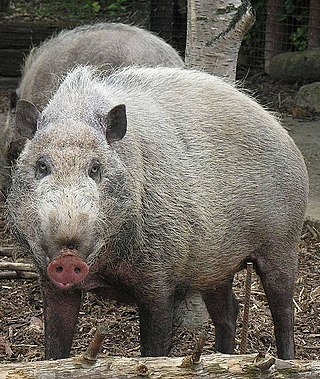
Sus is the genus of wild and domestic pigs, within the even-toed ungulate family Suidae. Sus include domestic pigs and their ancestor, the common Eurasian wild boar, along with other species. Sus species, like all suids, are native to the Eurasian and African continents, ranging from Europe to the Pacific islands. Suids other than the pig are the babirusa of Indonesia, the pygmy hog of South Asia, the warthogs of Africa, and other pig genera from Africa. The suids are a sister clade to peccaries.

The wild boar, also known as the wild swine, common wild pig, Eurasian wild pig, or simply wild pig, is a suid native to much of Eurasia and North Africa, and has been introduced to the Americas and Oceania. The species is now one of the widest-ranging mammals in the world, as well as the most widespread suiform. It has been assessed as least concern on the IUCN Red List due to its wide range, high numbers, and adaptability to a diversity of habitats. It has become an invasive species in part of its introduced range. Wild boars probably originated in Southeast Asia during the Early Pleistocene and outcompeted other suid species as they spread throughout the Old World.

The Auckland Islands are an archipelago of New Zealand, lying 465 kilometres (290 mi) south of the South Island. The main Auckland Island, occupying 510 km2 (200 sq mi), is surrounded by smaller Adams Island, Enderby Island, Disappointment Island, Ewing Island, Rose Island, Dundas Island, and Green Island, with a combined area of 626 km2 (240 sq mi). The islands have no permanent human inhabitants.
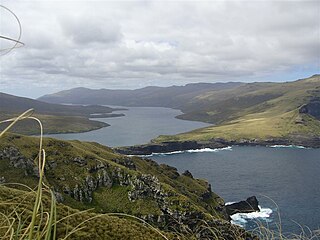
Auckland Island is the main island of the eponymous uninhabited archipelago in the Pacific Ocean. It is part of the New Zealand subantarctic area. It is inscribed in the UNESCO World Heritage list together with the other New Zealand Subantarctic Islands in the region.

The yellow-eyed penguin, known also as hoiho or tarakaka, is a species of penguin endemic to New Zealand.

The New Zealand sea lion, once known as Hooker's sea lion, and as pakake or whakahao (male) and kake (female) in Māori, is a species of sea lion that is endemic to New Zealand and primarily breeds on New Zealand's subantarctic Auckland and Campbell islands, and have in recent years been slowly breeding and recolonising around the coast of New Zealand's South and Stewart islands. The New Zealand sea lion numbers around 12,000 and is one of the world's rarest sea lion species. They are the only species of the genus Phocarctos.

A feral pig is a domestic pig which has gone feral, meaning it lives in the wild. The term feral pig has also been applied to wild boars, which can interbreed with domestic pigs. They are found mostly in the Americas and Australia. Razorback and wild hog are Americanisms applied to feral pigs or boar–pig hybrids.

Little Barrier Island, or Hauturu in Māori, lies off the northeastern coast of New Zealand's North Island. Located 80 kilometres (50 mi) to the north of Auckland, the island is separated from the mainland to the west by Jellicoe Channel, and from the larger Great Barrier Island to the east by Cradock Channel. The two aptly named islands shelter the Hauraki Gulf from many of the storms of the Pacific Ocean.
The Ponui or Ponui Island Donkey is a breed and feral population of domestic donkey from Ponui Island, in the Hauraki Gulf off New Zealand. It is the only feral donkey in New Zealand. It may also be called the New Zealand Donkey.
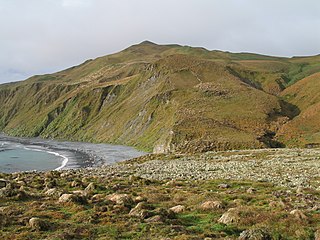
The Antipodes Subantarctic Islands tundra ecoregion, within the tundra biome, includes five remote island groups in the Pacific Ocean south of New Zealand: the Bounty Islands, Auckland Islands, Antipodes Islands and Campbell Island groups of New Zealand, and Macquarie Island of Australia.
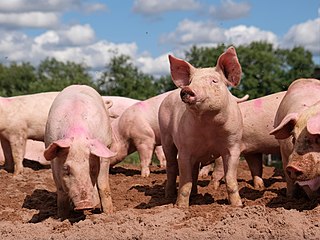
The pig, often called swine, hog, or domesticpig when distinguishing from other members of the genus Sus, is an omnivorous, domesticated, even-toed, hoofed mammal. It is variously considered a subspecies of Sus scrofa or a distinct species. The pig's head-plus-body length ranges from 0.9 to 1.8 m, and adult pigs typically weigh between 50 and 350 kg, with well-fed individuals even exceeding this range. The size and weight of hogs largely depends on their breed. Compared to other artiodactyls, a pig's head is relatively long and pointed. Most even-toed ungulates are herbivorous, but pigs are omnivores, like their wild relative. Pigs grunt and make snorting sounds.
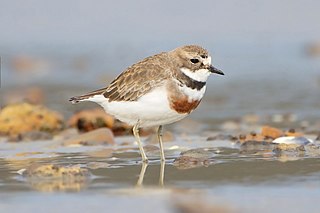
The double-banded plover, known as the banded dotterel or pohowera in New Zealand, is a species of bird in the plover family. Two subspecies are recognised: the nominate Charadrius bicinctus bicinctus, which breeds throughout New Zealand, including the Chatham Islands, and Charadrius bicinctus exilis, which breeds in New Zealand's subantarctic Auckland Islands.

Enderby Island is part of New Zealand's uninhabited Auckland Islands archipelago, south of mainland New Zealand. It is situated just off the northern tip of Auckland Island, the largest island in the archipelago.

The Tamworth is a British breed of domestic pig. It is the only red-coloured British pig. Its origins are unknown, but it appears to have developed near the town of Tamworth in south-eastern Staffordshire, close to Warwickshire border. It is one of seven British pig breeds listed by the Rare Breeds Survival Trust as 'priority', the highest level of concern of the trust.

The Rare Breeds Conservation Society of New Zealand (RBCSNZ) was founded in 1988 to conserve, record and promote rare livestock breeds with the aim of maintaining genetic diversity within livestock species. The area of coverage is broad, and includes poultry as well as camelids, cattle, chinchillas, deer, donkeys, goats, horses, pigs, rabbits and sheep.

Boar–pig hybrid is a hybridized offspring of a cross between the Eurasian wild boar and any domestic pig. Feral hybrids exist throughout Eurasia, the Americas, Australia, and in other places where European settlers imported wild boars to use as game animals. In many areas, a variable mixture of these hybrids and feral pigs of all-domesticated original stock have become invasive species. Their status as pest animals has reached crisis proportions in Australia, parts of Brazil, and parts of the United States, and the animals are often freely hunted in hopes of eradicating them or at least reducing them to a controllable population.

Carnley Harbour is a large natural harbour in the south of the Auckland Islands, a subantarctic part of the New Zealand Outlying Islands. Formed from the drowned crater of an extinct volcano, the harbour separates the mainland of Auckland Island from the smaller Adams Island. The harbour is sometimes referred to as the Adams Straits.

The Arapawa pig is a feral breed of domestic pig found on Arapaoa Island in the Marlborough Sounds, New Zealand. Although there are suggestions that the animals are descendants of pigs introduced to the area by James Cook in 1773 and 1777, they apparently derive from Oxford Sandy and Black stock brought to the island by whalers of the Te Awaiti whaling station established in 1827 by John Guard. They are known to have inhabited the island since 1839. In 1998 four piglets were removed from the island and have since bred successfully.

Cats are a popular pet in New Zealand. Cat ownership is occasionally raised as a controversial conservation issue due to the predation of endangered species, such as birds and lizards, by feral cats.

Victoria Forest Park, is situated on the West Coast of the South Island of New Zealand. At 2,069 square kilometres (799 sq mi) it is New Zealand's largest forest park. The park is administered by the Department of Conservation (DOC).
References
- ↑ National Committee (February 2004) [adopted 15 November 2003]. "Feral Breeds Policy Statement". Rare Breeds NewZ. Christchurch, NZ: Rare Breeds Conservation Society of New Zealand. Retrieved 7 October 2014.
- ↑ Robins, Judith H; Elizabeth Matisoo‐Smith; Howard A. Ross (June 2003). "The Origins of the Feral Pigs on the Auckland Islands". Journal of the Royal Society of New Zealand. 33 (2): 561–569. doi: 10.1080/03014223.2003.9517744 .
- 1 2 Fan, Bin; Jaime Gongora; Yizhou Chen; Olga Garkavenko; Kui Li; Chris Moran (June 2005). "Population Genetic Variability and Origin of Auckland Island Feral Pigs". Journal of the Royal Society of New Zealand. 35 (3): 279–285. doi: 10.1080/03014223.2005.9517784 . S2CID 128873673.
- 1 2 3 RBCSNZ: Auckland Island Pigs accessed 7 January 2008
- 1 2 3 4 5 6 7 8 9 Challies, C.N. (1975). "Feral Pigs (Sus scrofa) on Auckland Island: Status, and Effects on Vegetation and Nesting Sea Birds". New Zealand Journal of Zoology. 2 (4): 479–490. doi: 10.1080/03014223.1975.9517889 .